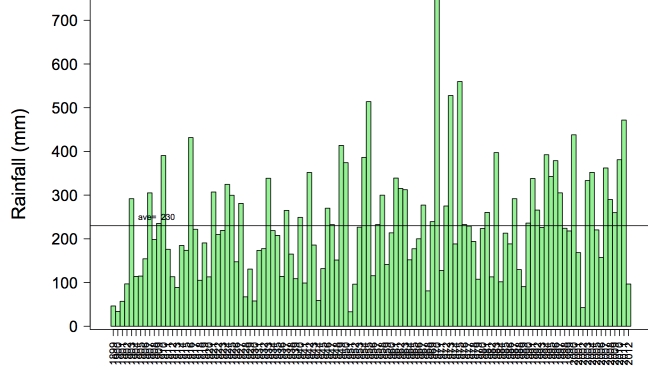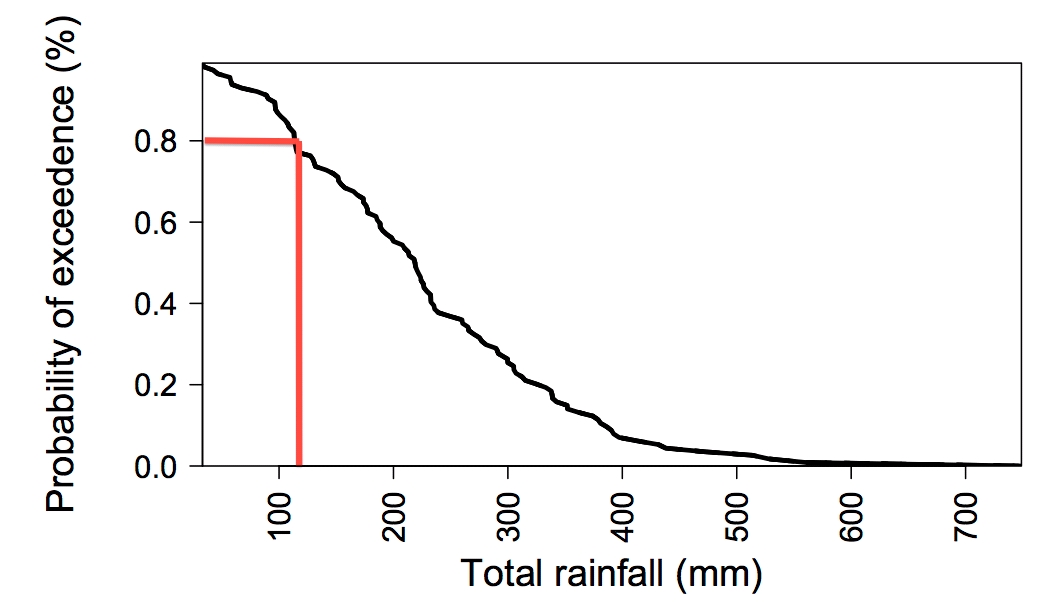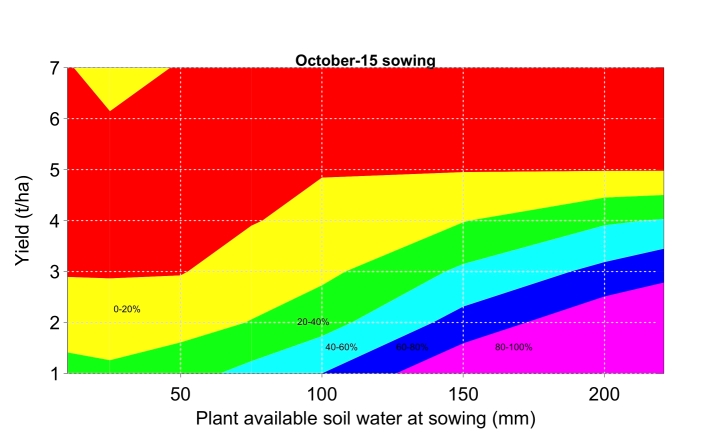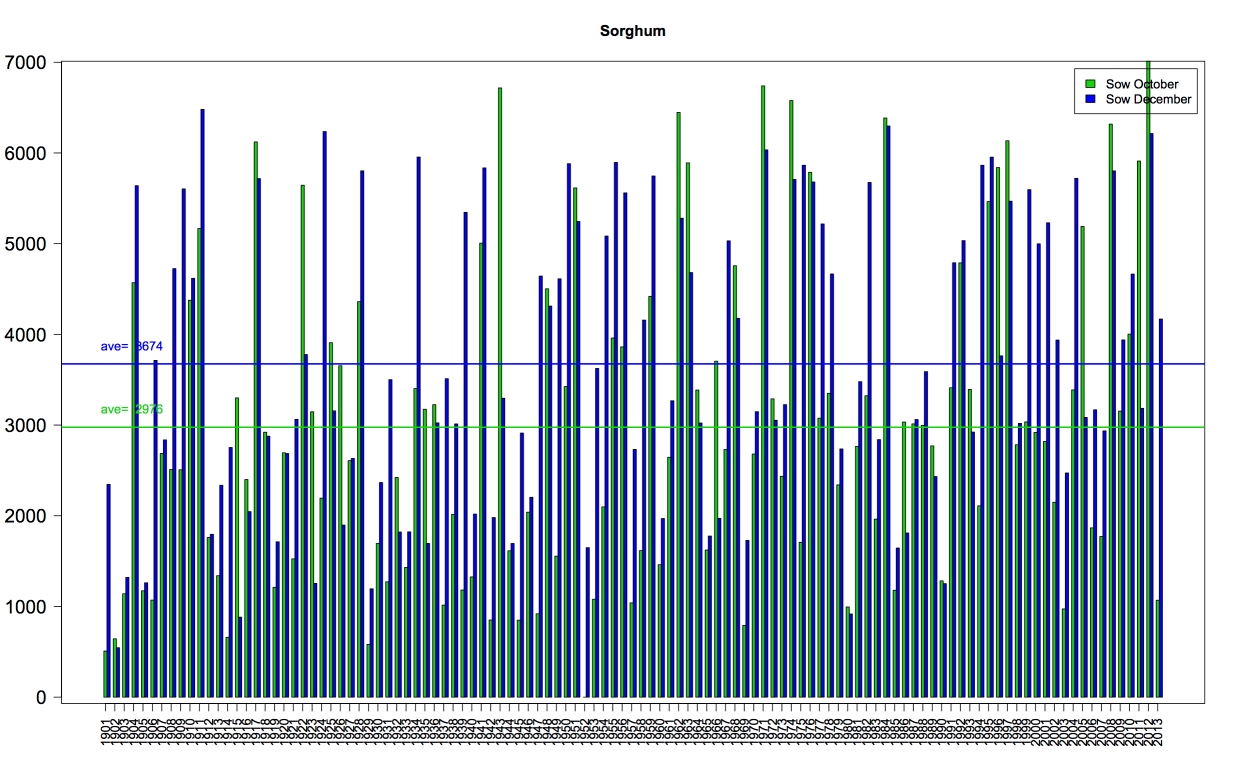Impact of stored water on risk and sowing decisions in western NSW
Author: Jeremy Whish, CSIRO Ecosystem Sciences Toowoomba 4350 / APSRU / APSIM initiative | Date: 23 Jul 2013
Jeremy Whish, CSIRO Ecosystem Sciences Toowoomba 4350 / APSRU / APSIM initiative
Take home message
- Before planting identify the target yield required to be profitable
- Do a simple calculation to see how much water you need to achieve this yield
- Know how much soil water you have (treat this water like money in the bank)
- Think about how much risk your farm can take
- Consider how this crop fits into your cropping plan, will the longer-term benefits to the system outweigh any short-term losses.
- Avoiding a failed crop saves money now and saves stored water for future crops
Introduction
Risk is personal, some people are more risk adverse than others and many factors influence how much risk an individual farm business can withstand. In this paper I will attempt to identify some tools and approaches that can inform and aid the planting decision process and identify how much risk is associated with different decisions. My aim is not to provide a recipe for planting summer crops in north-western NSW, but to provide some insight and tools to assist in the decision making process.
Why plant a summer crop
The highly variable nature of dryland farming in the western margins of the northern grain region can often be the very reason people are looking to plant a summer crop. If the previous season was dry and winter crops were not sown, a summer crop is likely to be the best way to generate cash flow. Alternatively, the summer crop may be part of a paddock management plan, a “break crop” designed to rejuvenate the paddock and improve subsequent winter crop yields by reducing weeds and disease and refilling the soil water profile. Finally it may be part of the farm plan, a phase in the cropping sequence where herbicides are rotated to reduce the chance of herbicide resistance, pest populations are reduced by growing non host crops, and farm operations and cash flow better managed by distributing work and returns between seasons. Whatever the reason, the important points to consider are: what benefits will my system get by including a summer crop; what crop do I intend to plant after the summer crop – will this influence the herbicides I use and what can I do to ensure my crop has the best chance to be profitable?
Once the decision on crop type is decided its time to think yield.
What is my yield target?
Targeting yield is an important consideration when producing crops in a variable climate. Having a target to aim for improves the decision making process, allowing the risk associated with planting under current conditions to be compared against future planting opportunities when conditions may be less risky. One approach is to look at the cost of planting a crop, how much it has already cost to keep the paddock fallow, and what yield is expected. I will give a brief example of how to do this and then concentrate on methods to estimate the final yield.
Decision
Do we plant sorghum on the 15- October or wait?
Background
To be grown on a Grey Vertosol soil in the Rowena district which has a maximum storage capacity of 221mm. The paddock has been fallowed from wheat in 2012 and has good stubble cover.
Costs
Fallow cost 5 sprays at $15/ha
Sowing costs $50/ha
In-crop chemical weeds/bugs $70/ha
Harvesting $45/ha
Fertiliser $90/ha
Total $330/ha
Many people don’t fertilise summer crops so this total can be reduced by $90, but it must be remembered that an under-fertilised crop has a reduced yield potential, effectively capping returns. This decision is up to the individual, but for this exercise fertiliser will be applied.
With the current price of sorghum between $130 -150/t a yield of 2.2-2.5 t/ha is required to break even. However, breaking even is not much of a goal when you are in farming to make a profit. Consequently, to make a 20% return yields of 2.6-3 t/ha would be the target.
While it is easy to talk about achieving a particular target yield, it is generally not that simple in practice. So what tools and information are at our disposal to make this a more likely reality?
How much water?
For a growing crop there are two sources of water; firstly the water stored in the soil during the fallow, and secondly the water that falls as rain while the crop is growing. You have some control over the stored soil water; you can measure how much you have before you plant the crop. However, rainfall is out of your control. Long-range forecasts and tools such as the SOI can indicate the likelihood of the season being wet or dry, but they cannot guarantee rain will fall when you need it.
Looking at the long-term climate records offers some insight.
Assuming that we plant on the 15th of October, the long term record (how many years) shows that the average amount of rain that will fall over the following 120 days is 230mm, however the seasonal rainfall range for this period is between 33mm and 749mm. Coefficient of variation (CV) is a statistical measure that describes how variable the data is, the larger the number the more variable, this period is quite variable (Figure 1) with 54% variation about the mean.

Figure 1. Long-term rainfall record for Rowena between the 15th of October and the 15th of February between 1900 and 2013.
A different way to look at this is via an exceedence plot (Figure 2) which presents the probability of exceeding a particular amount of rainfall within a particular time frame. If we look at the y axis and select 0.8 (or 80% or 4 in 5 years) and trace this across to the line and then down to the x axis it indicates that there is an 80% chance of getting more than 110mm of rainfall across the growing season. It should be noted however, that this also indicates that there is a 20% chance (1 in 5 years) of receiving less than 110 mm.

Figure 2. Probability of exceedence. Red lines show an 80% probability of exceeding 110 mm of in-crop rainfall if planting occurs on the 15th of October.
The later the crop is sown the greater the chance to accumulate in-crop rainfall and the less risky the planting decision. Table 1 shows that when planting between October and the 1st of January, there is an 80% chance of receiving at least 110-120mm of in-crop rainfall, however, this calculation does not consider the impact of rainfall timing on crop demand.
Table 1. In-Crop rainfall from different sowing dates assuming a 120 day crop.
|
Sowing date |
Ave in-crop rainfall (mm) |
Rainfall range Min-Max (mm) |
Coefficient of Variation (%) |
80% probability of exceeding (mm) |
|
15-Sep |
191 |
25 - 587 |
49 |
115 |
|
15-Oct |
230 |
33 - 749 |
54 |
110 |
|
15-Nov |
234 |
46 - 687 |
51 |
120 |
|
15-Dec |
227 |
17 - 649 |
53 |
120 |
|
01-Jan |
212 |
19 - 548 |
52 |
115 |
Converting water into grain
Crop factors indicate how a plant converts water into grain, if a water use efficiency factor of 15 (which means that for every mm of water taken up by the plant, the crop will produce 15 kg of grain per hectare, This value may be a little higher than you are familiar with because I am only talking about water used by the plant. many others use evapotranspiration which is water used by the plant and water evaporated from the soil. The value would be around 8-10 mm/kg/ha) is used for sorghum and we assume the plant uses all the rain that falls then on average a yield of about 1.7t can be achieved from 115mm of in-crop rainfall. However, much of this rainfall will be lost from the system via evaporation, or in some cases, runoff. The amount lost is hard to predict and depends on the intensity of the rainfall, the soil dryness at the time of the rainfall event, the length of time that radiation is reduced due to cloud cover and crop cover. Still, on average around 50 - 75% of this water will be lost from the system. This changes the scenario from 1.7 t/ha to around 0.4 – 0.8 t/ha.
Water stored during the fallow is the second source of crop water supply. Stored water is of higher value than rainfall because it is available when the plant needs it, provided that reserves are sufficient. In terms of risk management, the greatest value of stored water, is in knowing the quantity available for crop production, even before the crop is planted, when decisions are being made. It is also why managing fallow stubble cover and weeds is so important. Using the above example where the goal is to produce a crop in the region of 2.6-3t/ha, the analysis of rainfall shows an 80% chance of growing at least 0.4 - 0.8t on rainfall alone, so we need to derive the additional 2.2 -2.6 tonnes of planned production using the soil water reserves. Using our crop factor of 15kg of grain/ha/mm of water, this suggests that between 140 and 170 mm of soil water will be required. For simplicity sake lets say around 150mm soil water should achieve a 20% return on input costs or better 8 years in 10.
This calculation is fairly rough assuming that the efficiency of production is at 15kg/mm/ha whereas it may actually be a lot lower (or higher) depending on seasonal rainfall distribution and crop stage. An alternative approach, which does take into consideration the vagaries of seasonal rainfall distribution and amount, temperature, radiation and soil condition, is to use simulation modelling tools like APSIM, or its derivatives Yield Prophet™ or Whopper Cropper. These tools all use probability to describe the riskiness of particular actions like planting on a particular date ( as shown in Figure 2 ). Figure 3 shows an APSIM output prepared for Rowena looking at an October planting.

Figure 3. Rainbow chart showing the probability (colours) of achieving a particular yield (y axis) based on starting soil water conditions (x axis)
Figure 3 supports the back of the envelope calculation suggesting the 150mm of starting water is the minimum required to achieve a 3t yield 5 years in 10 while if you have 200mm of stored water the probabilities improve to 6-8 years in 10.
To sow or not?
Is it worth waiting to get more soil water? Within the Walgett region there is very little difference in yield between crops planted in September and December (Remember this is based on simulation runs that don’t consider heat stress, so some local experience is required). So how much water would you expect to accumulate within the soil by waiting to plant in December compared to October.
Looking at rainfall the average amount to fall in this period is 104 mm, but you have an 80% probability of getting at least 45mm (Figure 4).

Figure 4. Probability of exceedence and rainfall distribution between October 15 and December 15 from Rowena between 1900 and 2013.
Using APSIM’s soil water balance that considers runoff and drainage and assuming the soil profile held 130mm on the 15th of October, Two hundred and twenty millilitres of water on average would be accumulated by the 15th of December with an 80% probability of accumulating at least 185 mm. Under this scenario, waiting to accumulate more soil water is a viable option. It will increase the yields on average by 700kg (Figure 5). Sowing on 130mm in October has an 80% probability of exceeding 1.4 t/ha while waiting to December has an 80% probability of exceeding 2 t/ha. However, the tow month wait will increase the input costs by 1 or 2 herbicide sprays, but will also provide a better opportunity to control weeds.

Figure 5. Yield difference between planting on 130mm of stored soil water in October and accumulating more water for 2 months and planting in December. The average difference is 700 kg
Other tools
I have been conservative using 80% as my level of risk. However, a positive long range forecast, combined with a promising SOI signal, could be used to assess the scenario and accept a lower probability level to take a calculated increase in risk and sow on less soil water.
Alternatively, different sowing strategies could be used to reduce the risk of a failed crop. Skip row planting maintains a high plant density within the crop row, forcing the plants to experience early competition that limits tillering. As the plants approach grain fill the limited number of tillers are filled from the spared water in the skip, ensuring the crop is finished. The advantage of skip row is that it helps ensure a yield and prevents crop failure. However, the downside is that yield is capped due to the lack of tillers, so the crop cannot take full advantage of good rain and will yield less than a solid crop configuration when not under stress.
If the outlook is poor, reducing the area planted is also a way of hedging your bets and reducing the risk and expense of a failed crop. However, growing a non-profitable crop as part of a rotation can be tolerated, provided the benefits that crop provides to the over-all farm system is justified. Reducing weeds, managing herbicide resistance, and reducing disease inoculum are benefits of crop rotation that are not easily measured and not considered when using simple water use efficiency calculations or crop model simulations.
Conclusion
Deciding to plant or not is difficult, experience and gut feel are valuable components of this decision, however, by following some of the approaches presented here the decision can be made more transparent and justifiable. By thinking about the consequences of the planting decision on future crops, and how this crop fits into the overall whole farm system, the best decision will be made.
Contact details
Jeremy Whish
CSIRO Ecosystem Sciences
Ph: 07 4688 1419
Ph: 07 4688 1193
Email: Jeremy.whish@csiro.au
Acknowledgements
This work was funded by CSIRO, The Northern Growers Alliance, and GRDC. The time and assistance provided by Greg Rummery, Brad Coleman, Neil Newton and Simon Logan was greatly appreciated.
Reviewed by
Neal Dalgliesh and Greg Rummery
Was this page helpful?
YOUR FEEDBACK
